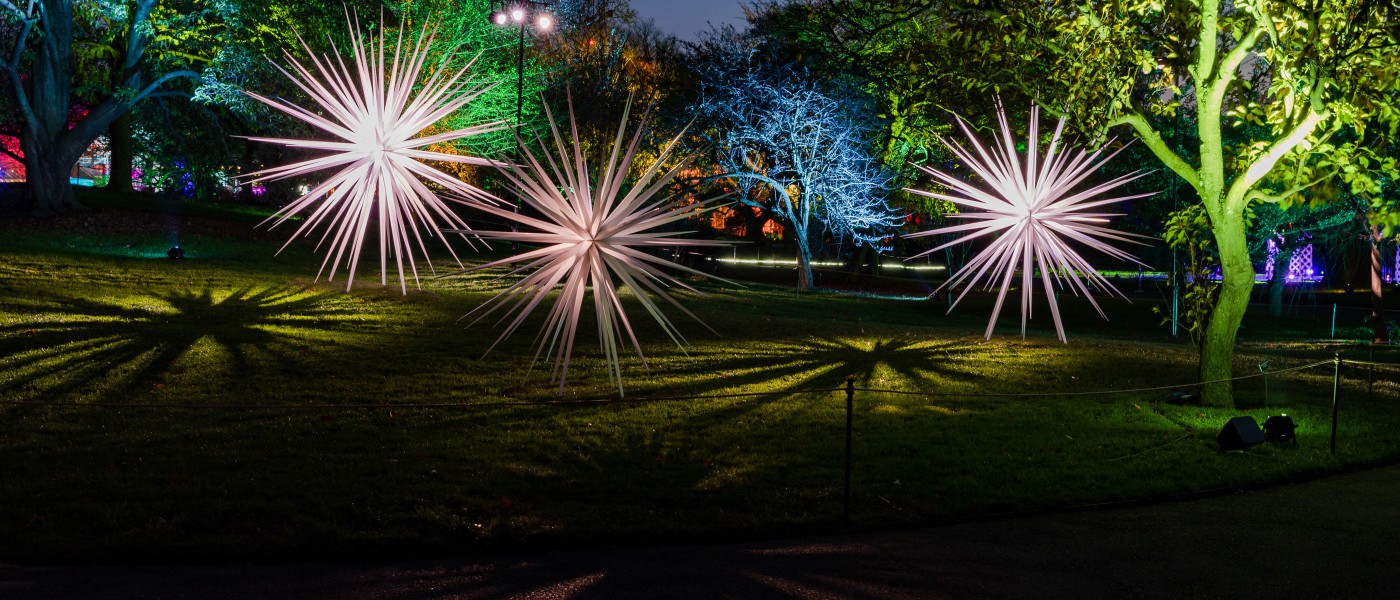How Do We Protect the Garden’s Collection During Lightscape?
Lightscape features a mile-long trail of lighted sculptures, water features, and dramatic bursts of light that cast the Garden’s landscape in an otherworldly kaleidoscope of color. You may be wondering: What does the Garden do to lessen the impacts of all those lights and heavy equipment on the plants and animals that live here?
Here Rowan Blaik, Brooklyn Botanic Garden’s vice president of Horticulture, answers some frequently asked questions.
Can the lights affect the Garden’s plants and trees?
As BBG president Adrian Benepe likes to say, the plants are the stars of the show. Showcasing—while protecting—the Garden’s collections is one of the major aims of Lightscape. Planning for this year’s event started in spring, and built upon what the Horticulture team learned from last year.
Artificial lights can affect the physiology of plants. Certain kinds of streetlamps, for example, can lead trees to hold onto very close leaves for an unnaturally long time. Lightscape features LED lighting that’s been installed mostly at ground level, pointing upward. The lights we use are less impactful to begin with, and that impact is diminished with distance, so these lights generally aren’t bright enough to affect the plants. We also try to be thoughtful about which trees we affix lights to, and which trees are illuminated by lights. Other factors, including time of year and temperature—many trees are going dormant around this time—help minimize any harm.
How does the Garden protect local wildlife from the bright lights and commotion of Lightscape?
We’ve deliberately chosen a trail for this program that winds along a main path that already gets a lot of disturbance. We tend to get the most wildlife activity in the quieter parts of the Garden, a bit farther back from the main path—in the Native Flora Garden, for example. We select suitable trees with our arborists and the production team, inspecting the trees beforehand for health and any associated wildlife.
What are some other ways you work to protect the Garden before and during Lightscape?
Installations were largely positioned in between plantings, and away from the root zones of plants. Anything affixed to trees or installed near root zones was put in place very carefully in an effort to avoid harm. All of the planning is really based around: Where should we have interventions in our landscape installations, and where shouldn't we? What type of installation is suitable, and what isn’t?
For example, there is an installation on Cherry Esplanade that creates the illusion of neon strings running between the cherry trees on either side. But instead of attaching the strings to the tree trunks, which could harm their bark, we installed posts aboveground between the trees and attached the strings to those posts.
The posts are secured by sandbags filled with horticultural-grade sand, which means that if a bag were to spill, it wouldn’t harm the pH of the soil or introduce harmful organisms. The posts were also deliberately placed at the edge of the trees’ root zones, where fewer roots could be affected by their weight.
Soil compaction is something we think about a lot when planning these kinds of events. A major component of soil is the air space that exists within it, in addition to all the minerals, water, and organic content. If the soil gets compacted down and that air is eliminated, you end up with a poor growing environment for roots and all the beneficial organisms in the soil.
What sorts of things do BBG staffers do to help the grounds recover after Lightscape ends?
We worked very hard this time around to keep infrastructure as much as possible on hard surfaces, and off things like lawns. The Winter Cathedral, for example, sits mostly atop a path. There will be a bit of reseeding, and maybe a bit of decompaction work on the lawns—that’s where we spike a lawn to get air down into the soil. But we learned a lot from last year, and from the planning stage forward, we tried to make sure there would be less wear and tear to recover from.





